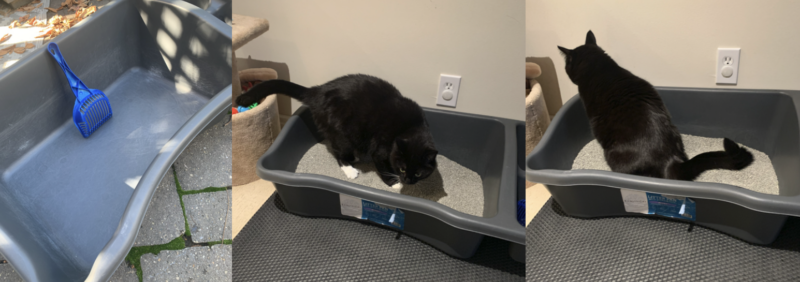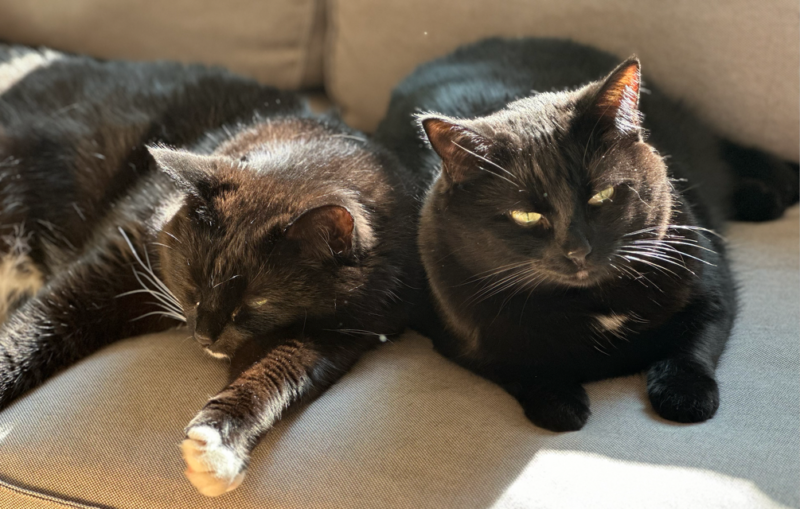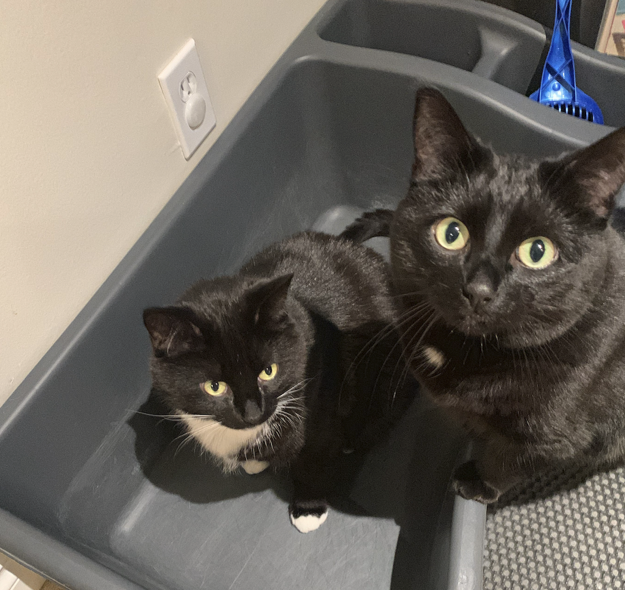By Elissa Bessonette, BSc, DVM, Graduate Certificate Shelter Medicine
One of the most common behavioural concerns for cats surrendered to shelters is the issue of periuria defined as the elimination of urine in unacceptable locations outside the litter box.1 Considering the motivation behind the behaviour, periuria is separated into marking and inappropriate elimination. This distinction is important because inappropriate elimination as defined by the human caregiver is not necessarily inappropriate for the cat. Determining adoptability requires an appreciation for the motivation behind the periuria. Careful collection of history related to house soiling concerns, assessment of the cat for any medical concerns, and transparent communication with adopters can lead to successful placement of these cats.
The clinician’s brief “Adoptability of Cats with Periuria”, suggests shelters (no-kill) may refuse to take cats with a history of periuria as they are more likely to be returned shortly after adoption. A retrospective study to assess the differences in outcomes between periuric and non-periuric cats was reviewed and found that cats with a history of periuria could have successful outcomes.
“Adoptability of Cats with Periuria” suggests that environmental factors often explain historical periuria and when explored using interventions of a medical assessment and a litterbox trial along with transparency to adopters there was no difference in adoption rates of cats with a history of periuria and non-periuric cats. Cats placed in alternate environments that were more supportive of their behavioural needs and elimination preferences allowed the cat to be successful post adoption.
Some of the takeaways from the clinician’s brief:
- History of inappropriate elimination does not deter most potential cat adopters
- Behavioural periuria has a high likelihood of resolution when the environment is changed to better suit the cat’s needs
- Establishing litter and litter box preferences at the beginning of a cat’s shelter stay and providing education and support for adopters may be key to successful adoption of cats with periuria.
I agree with the study referenced in the Clinician’s brief that a history of inappropriate elimination does not necessarily deter adopters from choosing that cat but there does need to be consideration for the fact that these cats have the potential to take longer to leave the shelter. A history of house soiling might not discourage all adopters but finding the person who can and is willing to make accommodations for the cat to be successful might take a little more time. Stay within your capacity to care for cats with a history of house soiling based on your ability to support and adopt them out. Placing house soiling cats on a waitlist before accepting them into the shelter should also be paired with owner support which may lend itself to intake diversion (can the current owner keep the cat once they understand the needs of the cat?). Collecting history (including medical records) prior to the cat being booked for intake often has clues as to why there is a concern (including intact status), and owners often have not sought the help of a veterinarian to determine if there is a medical component to the concern.
House soiling is detrimental to the human-animal-bond and owners can be reluctant to keep their cat despite support. If the owner cannot or will not provide the necessary resources, the cat may find what it needs in a different home. Ruling out medical versus behaviour concerns for the periuria is the first step to an adoption pathway.
Feline house-soiling problems are generally divided into two categories: inappropriate elimination and marking.
- Inappropriate elimination refers to cats who are emptying their bladder and/or bowels outside of the litter box (where their owners deem it inappropriate but if the cat finds the litterbox offensive, the cat is doing the best it can with the options provided). Inappropriate elimination is more likely when the cat refuses to use the litterbox, urinates, but does not defecate in the litterbox, eliminates beside the litterbox or stops covering eliminations (when previously they were covering) suggesting something in the experience has changed. These behaviours can be due to an underlying medical concern, aversion to litter (cat preference or negative association due to dirty conditions, previous pain in litterbox) or previous bad experience (i.e. ambushed). If there is feces involved in the inappropriate elimination of cat, anal gland assessment should be part of the physical examination.
- Marking is a social behaviour and a form of communication and in cats is typically urine rather than feces. 2Although some cats will urine mark on horizontal surfaces, spraying of urine by both male and female cats on vertical surfaces is most common. Behavioural motivation is more likely than medical in marking behaviour.3
Distinguishing between these two types of ‘house-soiling’ can be done using the following criteria:4
| Inappropriate Elimination | Marking |
| Usually, horizontal surfaces | Vertical surfaces-walls and drapes |
| Squatting position | Most cats will stand but some will squat |
| Large amounts of urine and/or feces | Small amounts of urination |
| Eliminates near the box but not in it | Areas of social significance |
| Digs/scratches to prepare spot and cover | Males, females; intact, neutered |
| Equally likely in male and female | Underlying medical conditions are uncommon |
| Underlying medical conditions are common |
When inappropriate elimination is the concern, it is necessary to rule out medical problems and address these issues. If the cat is medially cleared the next step is to determine the reason for an aversion to the litter box be it litter type, size of the box, location, feeling unsafe using this location or other anxiety producing concerns. I once went to a lecture where the ‘golden litter box’ was introduced as a method to deal with inappropriate elimination. This is a good place to start when discussing inappropriate elimination with cat owners be they current owners or potential adopters. Make that ‘toilet’ be the most appealing it can be for the cat (I’m not sure why golden would be appealing for the cat). This may take some individualized cat research but there are established preferences (cat determined, through research) that should be achieved.
- Cleanliness of the box is a common reason for cats to choose to eliminate in a less appropriate (for the human) place. Scoop the litterbox daily, change it out completely once weekly and wash with an unscented soap, allow to dry and refill to the cat’s preferred depth and litter type (generally clumping, clay type litter that is unscented.) One can test preference by offering a variety of litter types in separate litter boxes with other variables being equal and to the cat’s liking.
- Size does matter. Also to be considered is the size of the litter box and for those older cats, the height of the sides. The litter box should be at least 1.5 times the length of the cat (tail excluded) and despite human preference, cats typically prefer uncovered, unlined with clumping type litter. Older cats with mobility concerns may need a cut down entrance to improve litter box access.
- Location matters and litter boxes should be away from high traffic areas, not in places where cats can be startled or ambushed and not near furnaces, laundry or next to the cat’s food and water.
- Appropriate number of litter boxes = # of cats + 1

When marking is the issue and there are multiple cats in the household it is crucial to ensure there are adequate resources for each cat (not just litter boxes but also feeding stations, vertical spaces, sleeping areas, hiding spots and water bowls). Consultation with a veterinarian may determine that medication is indicated in cases of prolonged house soiling or where urine marking, and history suggests underlying stressors that cannot be eliminated. What causes a cat stress may be subtle and multifactorial, and it is entirely up to the cat what causes them stress…you might never know, and it doesn’t have to make sense to the human. Seeking the help of a veterinary behaviourist may be necessary for complex cases.

Never punish a cat for house soiling. Making the ‘inappropriate’ area less appealing to use for elimination involves thoroughly cleaning and blocking access (or providing an appropriate and attractive alternative in that space). Provide adequate resources for all cats in the home and ensure there are ways to address boredom and anxiety. Information on enrichment of indoor cats can be found HERE.
When inappropriate elimination does not appear to be related to a behavioural concern a visit to their veterinarian to rule out underlying medical conditions is advised. Conditions to rule out depend on the cat’s age and laboratory testing might be recommended if there are other clinical signs suggestive of systemic disease. Despite all the best efforts to help the owner keep the cat in their home it may not be possible or in the best interest of the cat. When the cat comes to the shelter, it is important that we screen the cat for underlying concerns and not just assume that a change in environment is going to be all that is required. Set the cat and the new owners up for success.
When a cat with history of house soiling arrives at the shelter, review the litter box report, medical records and animal profile. If you have trained medical support at your shelter, obtaining a urine sample shortly after intake (if there is a bladder and the cat can tolerate a cystocentesis) will expedite screening for underlying medical concerns. In younger cats, a full urinalysis often shows no concerns although there may be evidence of blood in the urine if feline lower urinary tract disease (FLUTD) is a component of the litterbox aversion. If there is a substantial amount of blood in the urine (not associated with cystocentesis), abdominal radiographs to survey the urinary tract is a great next step to rule out urolithiasis. If a urolith is present, a radiograph along with urinalysis should give you information on dissolution or surgery as your next step.
Not all shelters have access to laboratory or radiology equipment. Work with a vet in the community to draft protocols to screen inappropriate elimination cats who are more likely to have medical concerns based on their history and physical examination. Urine can be collected using collection sand like Nosorb (if the cat will cooperate and pee where you want it to) and be used to screen for medical conditions that cause polyuria/polydipsia. It is amazing what you can learn from pee. Cats should be able to concentrate their urine. A urine specific gravity below 1.035 should be followed up with a veterinarian for evaluation of the patient with lab work to rule out disease of the urinary tract (i.e. renal disease or less commonly, urinary tract infection) or diseases associated with polyuria (i.e. diabetes mellitus and hyperthyroidism).
A quick note on feline lower urinary tract disease (FLUTD). FLUTD refers to any condition of the urinary bladder and urethra of cats. It includes feline idiopathic cystitis (FIC), urolithiasis, urethral plugs, anatomic defects and neoplasia. FIC is associated with stress (hello shelter environment) and is the most common condition in this category for cats under 10 years of age.5 Risk factors for FLUTD include obesity, inadequate water intake, genetics, diet and stress. The small diameter of the male urethra and risk of blockage in cases of FLUTD requires that owners be aware that it is a medical emergency if the cat cannot urinate. Urinary tract infections are not common in adult cats.

In our shelter, if physical examination and urinalysis are normal and the history indicates the cat could do well in another home, cats are moved to adoption. We do not perform litter trials but offer clay litter or cat attract clumping litter (rather than the pine alternative) to cats with a history of house soiling. These cats do get adopted and since 2018 when we solicited the advice of a feline specialist in the community, we have received good feedback on the success of placement and what is being done by our shelter to support these cats in finding a new home.
We’ve been under water restrictions in Calgary for most of September. My cats had not had a deep clean of their litter box for three weeks and despite scooping daily and adding new litter they were starting to avoid burying their defecations…this is how they are telling me they are not happy with the state of their toilet. Not all households are able to investigate underlying concerns or adjust their routine or home to help their cat reliably eliminate where expected. We don’t want these cats in the shelter but there are adopters out there who are willing to give them a second chance and with assessment, transparency and support most can be successfully rehomed.
PS: Water restrictions were lifted on the 22nd of September at 10:00am and my cat’s litter boxes (yes, I am aware they are fat) were deep cleaned and reset an hour later providing the photos for this blog.
______________________________________________
References:
Herron, Meghan E., DVM, DACVB. Adoptability of Cats with Periuria. Clinician’s Brief. 2 Minute Takeaways. March 2022.
Liu, Sophie, Wailani Sung, Sarah Welsh and Jeannine M. Berger. A Six year Retrospective study of Outcomes of surrendered Cats (Felis Catus) with Periuria in a no-kill shelter. Journal of Veterinary Behaviour. Vol 42, Mar-Apr 2021. Pages 75-80.
Overall, Karen. MA, VMD, PhD, DACVB; Laurie Bergman, VMD, DACVB; Christine Calder, DVM, DACVB. CattleDogPublishing.com. What to do when your cat thinks outside of the Box. September 1, 2020.
Ruelle, Liz. DVM, DABVP (Feline Practice). Feline Lower Urinary Tract Disease (Information sheet). Wildrose Cat Clinic Calgary. 2018.
